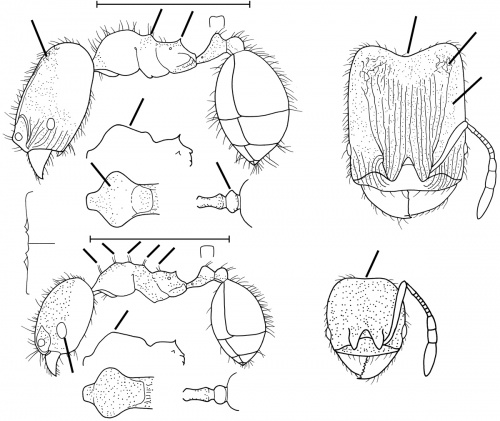Pheidole longinoi
| Pheidole longinoi | |
|---|---|

| |
| Scientific classification | |
| Kingdom: | Animalia |
| Phylum: | Arthropoda |
| Class: | Insecta |
| Order: | Hymenoptera |
| Family: | Formicidae |
| Subfamily: | Myrmicinae |
| Tribe: | Attini |
| Genus: | Pheidole |
| Species: | P. longinoi |
| Binomial name | |
| Pheidole longinoi Wilson, 2003 | |
P. longinoi inhabits wet forest, nesting in internodes of Cecropia insignis saplings (Longino 1997).
Identification
See the description in the nomenclature section.
Keys including this Species
Distribution
Costa Rica. (Wilson 2003)
Distribution based on Regional Taxon Lists
Neotropical Region: Costa Rica (type locality).
Distribution based on AntMaps
Distribution based on AntWeb specimens
Check data from AntWeb
Countries Occupied
| Number of countries occupied by this species based on AntWiki Regional Taxon Lists. In general, fewer countries occupied indicates a narrower range, while more countries indicates a more widespread species. |

|
Estimated Abundance
| Relative abundance based on number of AntMaps records per species (this species within the purple bar). Fewer records (to the left) indicates a less abundant/encountered species while more records (to the right) indicates more abundant/encountered species. |

|
Biology
Castes
Worker
Minor
Images from AntWeb
  
| |
| Worker. Specimen code casent0635483. Photographer J. Longino, uploaded by University of Utah. | Owned by JTLC. |
Nomenclature
The following information is derived from Barry Bolton's Online Catalogue of the Ants of the World.
- longinoi. Pheidole longinoi Wilson, 2003: 445, figs. (s.w.) COSTA RICA.
Unless otherwise noted the text for the remainder of this section is reported from the publication that includes the original description.
Description
DIAGNOSIS A small, medium yellow member of the flavens group, most similar to Pheidole otisi and Pheidole prolixa but easily distinguished from them in the major by the more prominent mesonotal convexity; smaller, more posteriorly directed propodeal spines; postpetiolar shape; and many details of cephalic sculpturing, including absence of rugoreticulum in the center of the occiput. The minor also differs in having the pilosity on the mesosomal dorsum limited to evenly spaced pairs of hairs.
P. longinoi is also similar but less so to Pheidole ceibana, Pheidole ruida and Pheidole sospes.
MEASUREMENTS (mm) Holotype major: HW 0.66, HL 0.82, SL 0.42, EL 0.08, PW 0.38. Paratype minor: HW 0.40, HL 0.44, SL 0.34, EL 0.08, PW 0.26.
COLOR Major and minor: concolorous medium yellow.
Figure. Upper: holotype, major. Lower: paratype, minor. Scale bars = 1 mm.
Type Material
COSTA RICA: 6.5 km east of Monteverde, Alajuela, 950 m, col. John T. Longino. Instituto Nacional de Biodiversidad
Etymology
In honor of the collector John T. (Jack) Longino, pioneer explorer of the Costa Rican ant fauna.
References
- Wilson, E. O. 2003. Pheidole in the New World: A dominant, hyperdiverse ant genus. Harvard University Press, Cambridge, MA. (page 445, fig. major, minor described)
References based on Global Ant Biodiversity Informatics
- Longino J. et al. ADMAC project. Accessed on March 24th 2017 at https://sites.google.com/site/admacsite/

